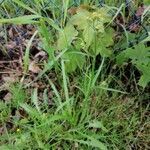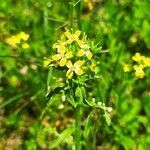Herbs annual, (4-)15-45(-70) cm tall. Trichomes malpighiaceous, mixed with fewer 3-forked ones. Stems erect, simple or branched at base. Basal and lowermost cauline leaves subrosulate, often withered by fruiting; petiole (0.3-)0.5-2(-3) cm; leaf blade linear, narrowly oblanceolate, elliptic, or oblong, flat, (1-)2-8(-11) cm × (2-)5-10(-15) mm, base attenuate, margin sinuate, coarsely dentate, denticulate, or repand, apex acute. Upper leaves sessile, usually smaller than basal, entire or denticulate. Racemes corymbose, densely flowered, ebracteate, elongated considerably in fruit. Fruiting pedicels divaricate, 2-4 mm, stout, about as wide as fruit. Sepals linear-oblong, 4-6 × 0.7-1 mm. Petals yellow, narrowly spatulate, 6-8 × 1.5-2 mm, apex rounded; claw subequaling sepals. Filaments yellow, 4-6 mm; anthers linear, 0.8-1.3 mm. Ovules (40-)50-80(-90) per ovary. Fruit narrowly linear, 4-angled, (2-)3-8(-10) cm × 1.5-2 mm, somewhat torulose, widely spreading or divaricate-ascending, straight or curved upward; valves with a distinct midvein, outside with malpighiaceous and fewer 3-forked trichomes on the outside, inside pubescent; style stout, 1-4 mm, cylindric or subclavate, sparsely pubescent; stigma slightly 2-lobed. Seeds oblong, 1.1-1.5 × 0.6-0.7 mm. Fl. Apr-Jul, fr. May-Sep. 2n = 14.
Annual, 2–4 dm, often much-branched; lvs linear to narrowly lanceolate or oblanceolate, the smaller often entire, the larger commonly conspicuously sinuate-dentate to pinnatifid; sep densely stellate, 4.5–5.5 mm; pet pale yellow, 6–10 mm; anthers 1 mm; mature racemes elongate, the rachis often zigzag, the pedicels very thick, divergent, 2–8 mm; frs widely spreading, 5–12 cm; 2n=14, 16. Native of Europe, found as an occasional weed in waste places in our range and westward. (Cheirinia r.)
Annual herb to 60 cm tall, erect, hairy; hairs medifixed, rarely 3-branched. Leaves linear-lanceolate to lanceolate, dentate to entire. Sepals 3–6 mm long. Petals 6–10 mm long, yellow, pubescent abaxially. Style 2–5 mm long; stigma emarginate. Siliqua linear, 4–10 cm long, 1–1.5 mm wide, terete to quadrangular; valves often tuberculate; pedicels spreading, 2–7 mm long. Seeds oblong, 1–1.7 mm long.


